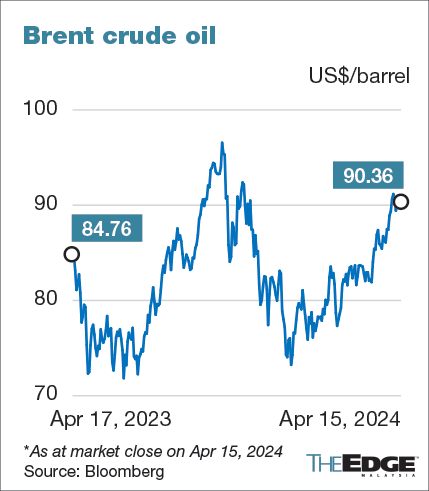
KUALA LUMPUR (April 15): United Overseas Bank Ltd (UOB) cautioned that if tensions in the Middle East continue to rise and disrupt Iran’s oil production, crude oil prices could climb towards US$100 per barrel (bbl) or even higher.
In a commodities strategy note on Monday, the research house highlighted the highly uncertain outlook for crude oil prices following Iran’s drone and missile attack on Israel, despite Brent, the global benchmark for crude oil, opening on Monday morning in Asia relatively unchanged, just above US$90 per barrel.
“Widespread diplomatic efforts from the US, EU and Arab states to de-escalate tensions between Israel and Iran have helped contain the fallout. However, significant risk remains due to the uncertain reaction from both countries,” it said.
UOB pointed out that current energy market indicators, including net non-commercial crude oil positioning, three-month implied volatility, and freight rates, suggest relatively contained risk compared to past disruptions, with Brent crude oil futures’ backwardation still distant from early 2022 levels during Russia’s invasion of Ukraine.
UOB emphasised that how the Organization of the Petroleum Exporting Countries (Opec) reacts will remain a key factor, given that Iran produces about four million barrels per day of crude oil, or 45% of Saudi Arabia’s production.
“If events worsen and threaten Iran’s crude oil production, a further spike in crude oil prices towards US$100 per barrel is highly likely,” UOB added.
However, the organisation also acknowledged that some Opec members, including Saudi Arabia, have adhered closely to production quotas, leaving room for potential production increases in the second half of the year to stabilise energy prices.
UOB maintains its forecast for Brent crude to reach US$90 per barrel by the fourth quarter of 2024, but acknowledges the volatility of the situation, especially considering the possibility of increased oil production from Saudi Arabia and Opec+ (Opec and allies) in response to market dynamics.
